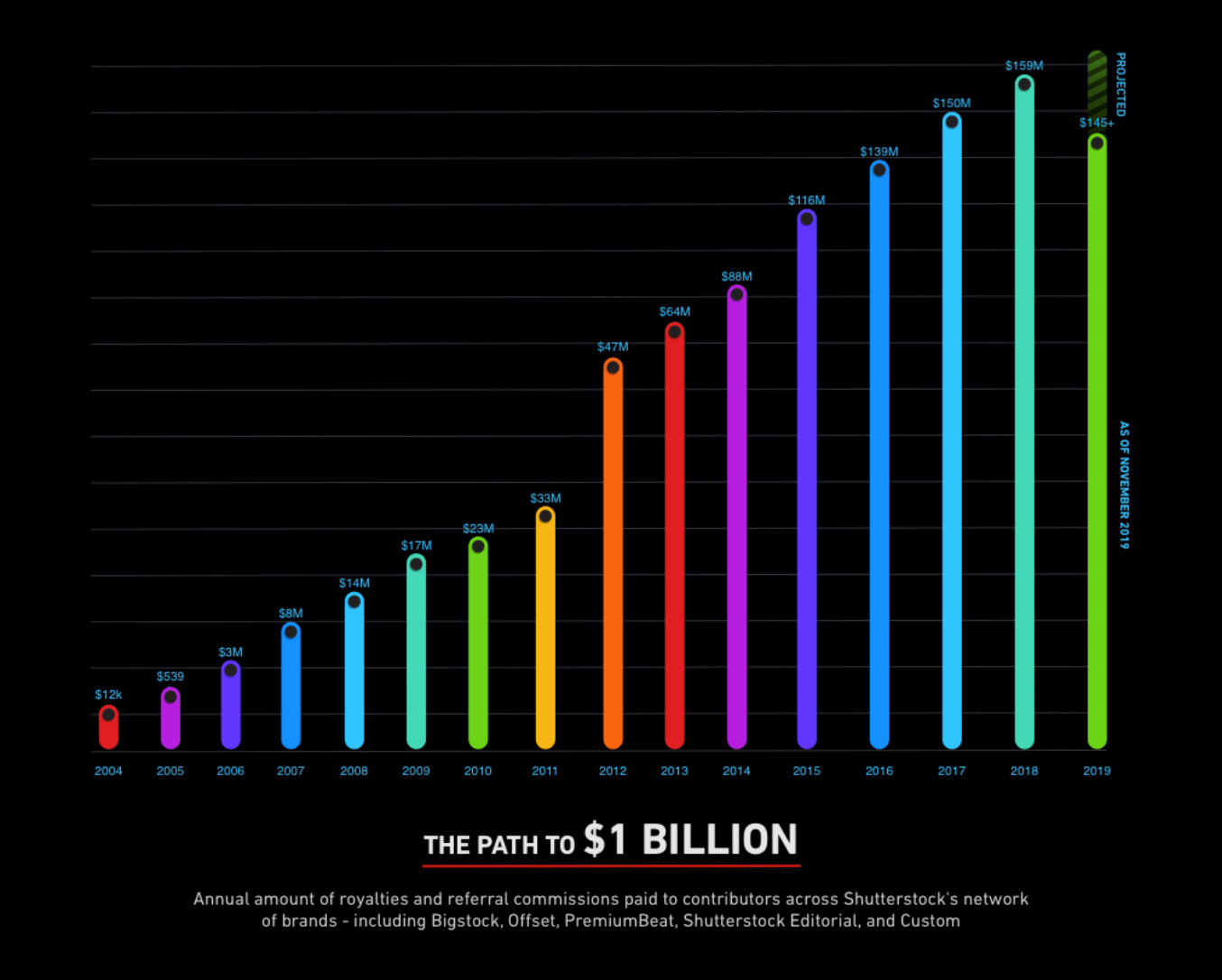Welcome! If you’re curious about making money through stock photography and images, Shutterstock is one of the biggest platforms out there. It connects talented content creators with millions of buyers worldwide, offering a great way to turn your creative work into income. But how exactly does Shutterstock generate revenue, and how do contributors earn? Let’s dive into the ins and outs of
Factors Influencing Earnings on Shutterstock
Your earnings on Shutterstock aren’t just about uploading pretty pictures—they depend on a variety of factors. First, the type of license sold makes a big difference. Standard licenses typically pay less, while enhanced or extended licenses can earn you more per sale. Quality and relevance of your images also play a crucial role. High-resolution, well-composed photos that match trending topics tend to sell more often.
Another key factor is your contributor level. Shutterstock has a tiered system: Contributor levels range from Standard to Elite. As you upload more and sell more, you progress through levels, unlocking higher royalty rates—sometimes up to 30% or more of the sale price. Consistent quality uploads and good keywording can help you climb these tiers faster.
Market demand and trending topics also influence your earnings potential. For example, during certain seasons or events, images related to holidays, sports, or current events tend to sell more. Keeping an eye on popular themes and updating your portfolio accordingly can boost your sales.
Lastly, the number of assets you have on Shutterstock matters. The more high-quality, relevant images you contribute, the higher your chances of making consistent sales. Regularly updating your portfolio, staying on top of visual trends, and optimizing your keywords can significantly impact your earning potential on Shutterstock.
Average Income of Shutterstock Contributors
If you’re curious about what kind of earnings you might expect as a Shutterstock contributor, you’re not alone. Many new contributors ask, “How much can I actually make?” Well, the truth is, earnings can vary quite a bit depending on several factors like the quality of your content, your niche, and how active you are.
On average, most contributors earn anywhere from a few hundred dollars to a few thousand dollars per year. To give you a clearer picture:
- Beginners: Usually start with lower earnings, often under $100 or $200 in their first few months. That’s totally normal as you’re just building your portfolio and understanding what sells.
- Intermediate contributors: Those who upload regularly and refine their skills might make between $500 and $2,000 annually.
- Top creators: The most successful contributors, especially those who produce high-demand content in popular niches, can earn $10,000 or more per year. Some even hit six figures, but it takes time, consistency, and a strategic approach.
It’s also good to remember that Shutterstock pays contributors based on a royalty system. The more your images, videos, or illustrations are downloaded, the more you earn. Plus, your earnings can grow as you improve your content quality and diversify your portfolio.
Most importantly, keep in mind that Shutterstock is often seen as a long-term game. Building a steady stream of income might take months or even years, but with persistence, many contributors find it to be a rewarding side hustle or even a full-time gig. Every contributor’s journey is unique, so focus on creating quality content and stay consistent—you might be surprised by your earnings over time!
Tips to Maximize Your Earnings on Shutterstock
So, you’re eager to boost your income as a Shutterstock contributor? Great! The good news is, there are some proven strategies to help you get the most out of your uploads and turn your creativity into a steady income stream.
Here are some top tips to maximize your earnings:
- Create High-Quality Content: Always aim for sharp, well-lit, and professionally composed images and videos. High-quality content is more likely to be downloaded and featured in premium collections.
- Find Your Niche: Focus on a specific niche or style that suits your skills and interests. Whether it’s travel photography, business graphics, or lifestyle videos, having a specialty can make your content stand out.
- Research Popular Topics: Keep an eye on trending topics and seasonal themes. Content that aligns with current demand tends to perform better and earn more downloads.
- Use Effective Keywords: Proper keywording is crucial. Use relevant, specific, and descriptive keywords to help your content surface in search results. Think from the buyer’s perspective and include synonyms and related terms.
- Upload Consistently: Regular uploads keep your portfolio fresh and increase your chances of being discovered. Set a schedule that works for you and stick to it.
- Engage with the Community: Participate in Shutterstock’s contributor forums, attend webinars, and stay updated on platform changes. Networking can provide valuable insights and motivation.
- Analyze Your Portfolio: Use Shutterstock’s analytics tools to see which types of content perform best. Focus on creating more of what works and improve or retire less successful pieces.
- Stay Updated on Platform Policies: Make sure your content complies with Shutterstock’s guidelines to avoid rejections that can slow down your earnings.
Remember, patience and persistence are key. The more effort you put into creating quality content, understanding the market, and optimizing your uploads, the better your chances of maximizing your earnings. Keep learning, stay consistent, and enjoy the creative process—your efforts will pay off!
Comparing Shutterstock Income with Other Stock Photography Platforms
When it comes to earning as a content contributor, it’s important to see how Shutterstock stacks up against other popular stock photography platforms. Each platform has its own way of rewarding contributors, and understanding the differences can help you make informed decisions about where to focus your efforts.
Shutterstock is known for its extensive global reach and a large customer base, which often translates into consistent sales for contributors. Its royalty structure is quite straightforward: contributors earn a percentage based on their exclusivity status and sales volume. Typically, contributors can earn anywhere from 15% to 40% per download, with higher percentages awarded for exclusive content.
In comparison, platforms like Adobe Stock tend to offer similar royalty rates, usually around 33% for standard contributors, but they also have a different licensing model that might impact earnings. Getty Images and iStock (owned by Getty) often offer higher payouts per sale but may have more stringent acceptance criteria and a more selective process.
Here’s a quick comparison:
| Platform | Royalty Rate | Exclusive Content Bonus | Additional Notes |
|---|---|---|---|
| Shutterstock | 15% – 40% | Yes, higher for exclusive content | Large customer base, easy to upload |
| Adobe Stock | 33% | No | Integrated with Creative Cloud, good for designers |
| Getty Images/iStock | 15% – 45% | Yes, higher for exclusives | More selective, higher earning potential per sale |
| Alamy | 40% – 50% | No | Offers some of the highest royalties, less strict on content |
While Shutterstock might not always offer the highest payout per image, its sheer volume of potential buyers and straightforward platform can make it a very profitable choice, especially for those just starting out or aiming for steady income. Other platforms might pay more for individual images, but they often come with more competitive submission standards or less frequent sales.
Ultimately, diversifying your portfolio across multiple platforms can help maximize your annual earnings. Many successful contributors upload to Shutterstock alongside other sites to reap the benefits of different licensing models, customer bases, and payout structures. Think of it as creating a balanced income stream—relying solely on one platform might limit your earning potential, but spreading out your efforts can open up more opportunities for consistent revenue.
Conclusion and Final Thoughts on Earning Potential from Shutterstock
So, what’s the bottom line when it comes to earning from Shutterstock? Well, if you’re a content creator looking to turn your passion into profit, Shutterstock offers a solid platform with a lot of potential. Its large customer base, straightforward royalty system, and ease of use make it an attractive choice for many contributors.
While the earnings can vary widely depending on the quality and popularity of your images, consistent uploading and strategic keywording can significantly boost your income over time. Remember, building a diverse portfolio that appeals to various niches can help you tap into different markets and maximize your earnings.
It’s also worth noting that Shutterstock’s earnings are cumulative. As you upload more high-quality content and become more familiar with what buyers are looking for, your earning potential naturally increases. Plus, with additional options like exclusive content, you can earn higher royalties, further boosting your annual income.
Keep in mind that earning from stock photography isn’t usually an overnight success. It requires patience, persistence, and continual improvement of your skills. But for many contributors, the passive income generated from stock photos can become a significant part of their overall earnings, especially when they diversify across multiple platforms.
In summary, Shutterstock can be a lucrative platform if approached thoughtfully. By understanding its earning structure, comparing it with other platforms, and consistently uploading quality content, you can unlock its full earning potential. So, keep shooting, keep uploading, and watch your income grow!



